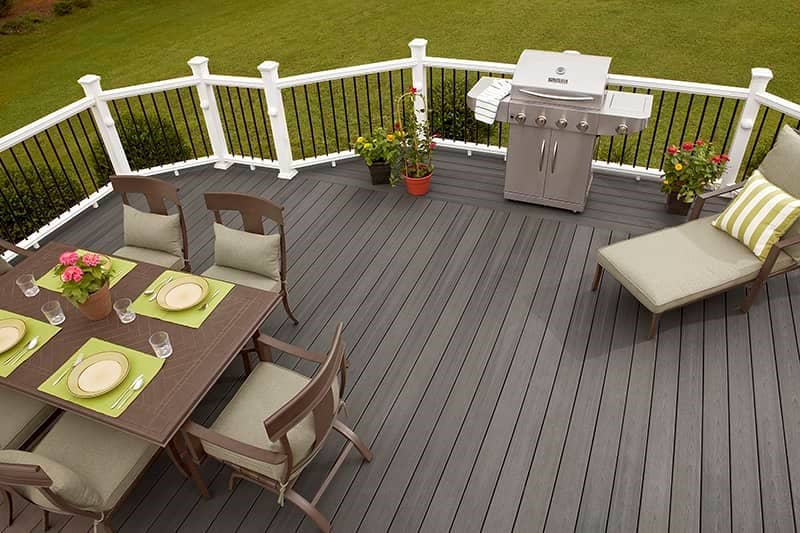
“Is the juice worth the squeeze?”

You may have heard this cliche. It’s newish, but it’s caught on. And well it should: “Is the juice worth the squeeze” conveys something essential about problems. Problems aren’t deal-killers, they’re part of the process.
Ask yourself: has any great product or service you’ve used not had problems? You’re probably shaking your head. You’re probably realizing that a good thing, whatever it is, isn’t measured by a lack of problems, but by whether its juice is worth its squeeze.
This question applies to any choice you make about your outdoor living. Any project or product you pick will have its cons. The question is: are the pros (juice) worth the cons (squeeze)?
What is composite decking?
Composite decking is a (semi) artificial alternative to regular wooden decking.
What’s composite decking a composite of? Recycled plastic, glue, and wood fibers. Those wood fibers are often chips, shreds, or even sawdust. Melt and mix those three, then stamp them to look like real wood, and you’ve got composite decking. If you want more steps, this visual from Fiberon, a major composite manufacturer, explains:
Trex invented modern composite decking in 1996, meaning Trex is now old enough to drink and vote. Since then, multiple competitors– Fiberon, TimberTech, Envision, CertainTeed, Barrette, others– have appeared.
The advantages are clear: composite decking takes less upkeep than real lumber, lasts longer if treated right, and saves you money in the long run. That’s the juice. What’s the squeeze?
-
Higher initial cost
The initial cost for composite decking will generally be higher than the initial cost for pressure-treated lumber. Composite decking costs 35% more, at least in the case of one reporter at Consumer Reports. Generally speaking, a composite deck is about $60-80 per square foot, whereas a wooden one is $50-65.
Put in different terms, a 12-foot board of Trex’s lowest-quality brand is $24, where a 12-foot board of cheap pressure-treated lumber is $12.
Using the decks.com cost calculator, the materials for a 20x20 (ish) pine deck is usually a few thousand dollars less than a composite deck of the same plan.
A $2-3,000 difference between pine and composite, in these examples
That said, composite true believers will counter that long-term costs are higher for lumber. That’s thanks to the need to reseal lumber decks once a year, as well as the higher likelihood of mold, mildew, and other forms of structural damage.
-
Fading colors and warping boards
While earlier composite decking materials were more susceptible to fading, modern capping methods have largely eliminated fading as a major problem. Nonetheless, merchants like Fiberon and Trex offer fade and stain resistance warranties that run from 20 to 50 years.
Further fading can occur thanks to the sun’s rays, further weathering, or damage by heavy deck furniture. And while color fading is great for that $80 hypercolor shirt on Poshmark, it’s not good for your deck.
Yes, $80. This is why you throw nothing away.
-
Not mold proof (just mold resistant)
Composite decking may be less likely to mold than regular wood, but mold and rot are still possibilities. They become even more possible if the capping, or plastic outside layer, gets scratches where water can collect. The older, “first generation” composite boards lacked any capping at all, so mold and mildew were just as much of a risk as for lumber. Earlier versions of composite decking had enough mold problems to inspire a few class-action lawsuits.
These days, composite decking tends to be capped on three or four sides of the board. Three-sided capping is more likely to get mold and mildew damage. There are ways to deal with mold and mildew, however, like this tip for the ends of boards, or this tip for cleaning composite decking.
-
Fake factor (most people prefer real wood)
Here’s an uncontroversial hot take: most people prefer the look of real wood to fake wood. Words and phrases like “warmth,” “authenticity,” and “homey feel” accompany descriptions of wood in the composite-vs.-wood debate.
The difference will be noticeable to most people:
Courtesy of Jacksons Fencing
It’s not just the difference between grey and light brown. It’s the differences in the light brown on the right. That multi-shade appearance in real lumber is thanks to the difference between colors in the inner part of the original tree, and the outer part (called xylem and phloem, or hardwood and sapwood, respectively).
Composite decking is dyed by a chemical process. Real lumber is “dyed” by the process of the tree’s outer sapwood becoming hardwood, and gradually changing color in the process. That process creates intricacies of color no human process can match– hence the “authenticity” of real wood.
That said, some composite fans beg to differ:
Ipe’s a tropical hardwood. Comically direct ad, but it did get me to click.
-
Heat
If you live in a hot climate, composite decking will get hot. Even in a temperate climate, direct sunlight can make composite decking uncomfortable. This video shows the temperatures of different shades of composite decking getting up to 200 degrees Fahrenheit: https://www.youtube.com/shorts/eHAOU4nBHbo
If you’ve got small children or pets who’ll use the deck regularly, you’ll want to find a way to mitigate the heat of composite boards. Outdoor rugs are one good way to handle it, as are pergolas, or other features that provide shade.
Are composite decking’s disadvantages worth the squeeze?
So is composite decking’s juice worth the squeeze? It depends on your needs. If you’re someone who tends to keep an outdoor space clean, and plan to be in your house for a long time, composite might be a good material for you.
If you’re ready to take the next step in buying a composite deck, there are multiple options for financing your outdoor living project. There are also clear signs about whether or you and a potential contractor are a good fit. If you think we’d be a good fit, we’d love to hear from you online, or at (240) 266-5900.
Phil Parsons is an owner at KP Contracting with 20-years’ experience in custom remodeling and the development of outdoor living spaces that bring friends and family together. He is a degreed engineer, and his work has been featured on HGTV.
Topics:
